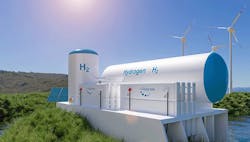Hydrogen handling for safe sustainability
As if the usual moral and economic motivations weren't enough, process safety will also be needed as many industries and communities shift to alternative energy sources like solar and wind—especially as they use far more hydrogen for energy storage and transport.
"Energy users are transitioning from fossil to alternative sources, but it must be done more sustainably and safely. One of the main pushes will be into a hydrogen-based economy, which seems to be viable and clean, but also carries many unknowns that need to be addressed," says Faisal Khan, director of the Mary Kay O'Connor Process Safety Center (MKOPSC) at Texas A&M University. "Users have been working with hydrogen for many decades, of course, but in relatively limited amounts, and not as a fuel, but rather as a chemical. If it's going to help with transitioning to alternative energy production and supply chains, we're talking about using far greater quantities. It's also such a small, highly energetic molecule that it doesn't need an ignition source. Plus, it also makes metal brittle, including the metal it's stored in. These are some of the challenges that must be addressed as more hydrogen is used. However, the problem we've observed is that new solutions are being proposed without a deeper understanding of why existing materials and supply chains aren't enough."
Similar to regular process safety, Khan reports that large-scale hydrogen production, handling and consumption as a fuel begins with identifying its basic hazards, and determining how its hazardous properties will affect plans for use and containment. Once these properties are understood, users can begin to determine how accidents can happen, and how to prevent and respond to them by changing designs, controlling events, and mitigating them where possible.
This article is part of a series on process safety. Check out the rest of the series here.
"Hydrogen is already well-known, but it's been a small piece of the overall energy puzzle so far. We aren't as familiar with it as a fuel, so we need to understand it from a different point of view," explains Khan. "A good starting point is lab studies about hydrogen production and interactions with containment that can show its mechanisms of degradation and potential accident causation. We're already doing this in a small lab at MKOPSC. However, the big unknown is scaling up production and transport because system dynamics and related properties can change. This must be studied more, so we're working with our clients on it."
Khan adds that scaling up hydrogen will likely require more infrastructure, and digitalized tools and software will be able to help new hydrogen production facilities run safely in remote locations, including offshore. "This will only be possible with digitalization for monitoring, operations and maintenance from safer distances," says Khan. "In fact, MKOPSC has already been working with the Dept. of Energy and Dept. of the Interior on the $40 million, U.S.-funded Ocean Energy Safety Institute (OESI), which was established in 2020 to help implement more sustainable and safer technologies at offshore oil and gas sites, and show how wind and marine energy producers can benefit from safety lessons already used by fossil fuel producers. Most wind and marine energy facilities are new, and face installation, operations and maintenance challenges that can impact their safety, so best practices longer-established producers in other industries could be useful."
About the Author

Leaders relevant to this article:


